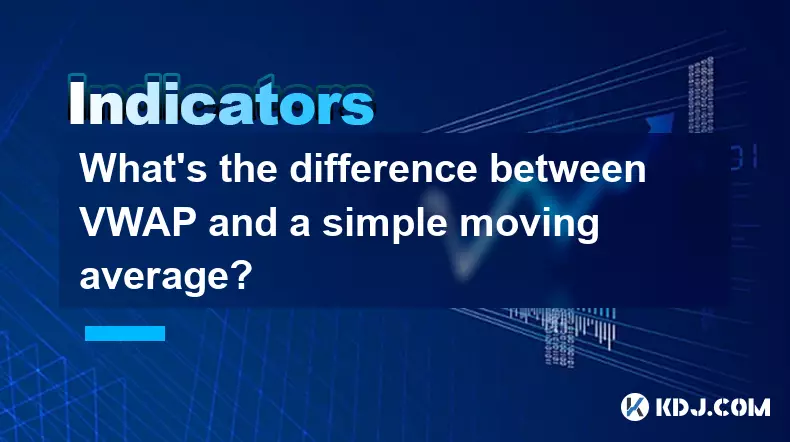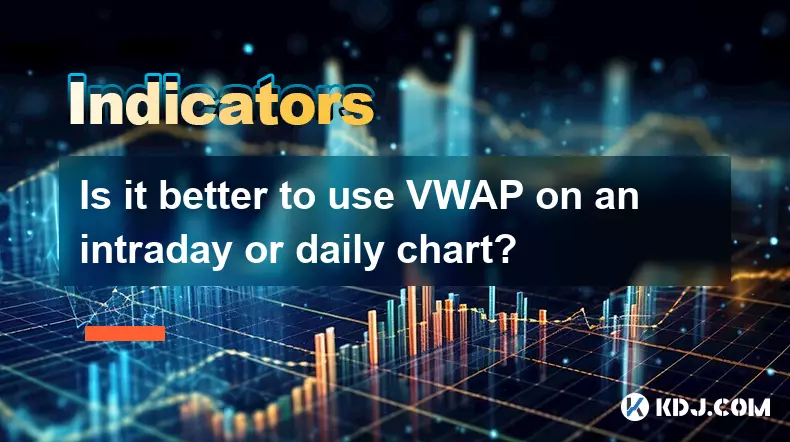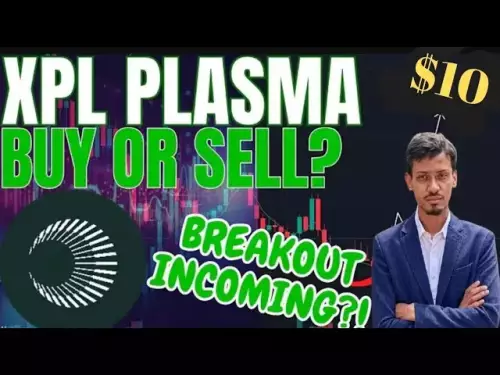-
 bitcoin
bitcoin $110918.433029 USD
-1.69% -
 ethereum
ethereum $3996.872473 USD
-2.43% -
 tether
tether $1.000594 USD
0.00% -
 bnb
bnb $1178.871834 USD
-2.38% -
 xrp
xrp $2.413973 USD
-3.47% -
 solana
solana $194.341461 USD
-4.24% -
 usd-coin
usd-coin $0.999963 USD
-0.03% -
 tron
tron $0.320092 USD
0.92% -
 dogecoin
dogecoin $0.196919 USD
-3.42% -
 cardano
cardano $0.669585 USD
-3.63% -
 hyperliquid
hyperliquid $37.485952 USD
-3.58% -
 ethena-usde
ethena-usde $1.000026 USD
-0.02% -
 chainlink
chainlink $18.018220 USD
-5.13% -
 bitcoin-cash
bitcoin-cash $523.879267 USD
-2.41% -
 stellar
stellar $0.324655 USD
-3.67%
What's the difference between VWAP and a simple moving average?
VWAP combines price and volume to reveal true market sentiment, helping traders gauge momentum and execute orders efficiently in volatile crypto markets.
Oct 12, 2025 at 03:20 am

Understanding VWAP and Its Role in Trading
1. The Volume Weighted Average Price (VWAP) is a trading benchmark that represents the average price a cryptocurrency has traded at throughout the day, based on both volume and price. It is widely used by institutional traders to assess market trends and execute large orders without significantly impacting the market price.
2. Unlike traditional averages, VWAP incorporates volume as a weighting factor, meaning periods with higher trading volume have a greater influence on the value. This makes it more reflective of actual market activity compared to price-only indicators.
3. In the crypto markets, where volatility and liquidity can shift rapidly, VWAP helps traders identify whether they are buying or selling above or below the average cost of the asset for the current session. This insight supports better decision-making during high-frequency or algorithmic trading strategies.
4. One key advantage of VWAP is its ability to reveal hidden support and resistance levels influenced by transaction volume, offering deeper context than price-based signals alone.
5. Traders often use VWAP as a dynamic reference point, especially in intraday trading. When the current price is above VWAP, it may indicate bullish momentum; when below, bearish sentiment could be prevailing.
How Simple Moving Averages Function in Crypto Analysis
1. A Simple Moving Average (SMA) calculates the arithmetic mean of a cryptocurrency’s price over a defined number of past periods. For example, a 20-period SMA adds up the closing prices of the last 20 intervals and divides the sum by 20.
2. SMAs are commonly applied across various timeframes—such as 9, 20, 50, or 200 periods—to identify trend direction and potential reversal zones. They smooth out price data to form a single flowing line, making patterns easier to interpret.
3. Because SMAs treat each period equally, they do not account for how much volume occurred during those intervals. This can lead to misleading signals during low-volume periods that still carry the same weight as high-volume ones.
4. The simplicity of SMAs makes them accessible for beginners, but their lack of volume integration limits their accuracy in fast-moving digital asset markets.
5. Many traders combine multiple SMAs—like the 50-day and 200-day—to detect crossovers, which are interpreted as buy or sell signals depending on the directional shift between the two lines.
Key Differences Between VWAP and SMA
1. Calculation methodology differs fundamentally: VWAP uses intraday price and volume data from the start of the session, recalculating cumulatively, while SMA relies solely on closing prices over a fixed lookback window.
2. VWAP resets at the beginning of each trading session, typically aligned with UTC or exchange-specific timestamps in crypto, whereas SMA continues rolling forward without reset, maintaining continuity across days.
3. VWAP is inherently tied to real-time execution quality, particularly useful for minimizing slippage in large trades, while SMA serves more as a lagging trend indicator.
4. SMA values depend entirely on the chosen period length and are blind to trading intensity, making them prone to false breakouts during thin markets. VWAP adjusts dynamically to volume surges, reducing susceptibility to noise.
5. Charting platforms display VWAP as a single intraday line that evolves with new data, while SMAs appear as continuous curves extending backward and forward across all candles regardless of session boundaries.
Frequently Asked Questions
Can VWAP be used effectively in 24/7 cryptocurrency markets?Yes, VWAP is adapted in crypto by defining specific time windows—often daily cycles starting at 00:00 UTC—allowing traders to apply it consistently despite the absence of traditional market hours.
Why might a trader prefer SMA over VWAP?Some traders favor SMA for its simplicity and long-term trend clarity, especially when analyzing weekly or monthly charts where volume nuances matter less than directional bias.
Is VWAP suitable for retail investors?Absolutely. While originally designed for institutional order execution, retail traders benefit from VWAP by aligning entries and exits with institutional flow patterns visible through volume-weighted benchmarks.
Disclaimer:info@kdj.com
The information provided is not trading advice. kdj.com does not assume any responsibility for any investments made based on the information provided in this article. Cryptocurrencies are highly volatile and it is highly recommended that you invest with caution after thorough research!
If you believe that the content used on this website infringes your copyright, please contact us immediately (info@kdj.com) and we will delete it promptly.
- Hedera (HBAR) to $1: Can It Actually Happen?
- 2025-10-17 03:05:15
- Nevada Coin Mart: Where the Sparkle Meets Serious Coin Collecting
- 2025-10-17 02:45:17
- BNB Whales Eye $LIVE Presale: The Next Big Crypto Opportunity?
- 2025-10-17 03:30:16
- Solaxy, Super Pepe, and Presales: What's the Buzz?
- 2025-10-17 03:05:15
- $IPO Token Presale: Aiming for $100M AUM and Revolutionizing Early Investment
- 2025-10-17 02:45:17
- Decoding Crypto's Crossroads: Navigating Volatility with 'Digital Asset Treasuries' and Ethereum's Scaling Solutions
- 2025-10-17 03:30:16
Related knowledge

What's the main difference between VWAP and TWAP?
Oct 12,2025 at 11:54am
Understanding VWAP and Its Role in Crypto Trading1. Volume Weighted Average Price (VWAP) is a trading benchmark that calculates the average price of a...

How do you identify exhaustion moves using VWAP and its bands?
Oct 12,2025 at 08:00am
Understanding the Role of Decentralized Exchanges in Crypto Trading1. Decentralized exchanges (DEXs) operate without a central authority, allowing use...

Is it better to use VWAP on an intraday or daily chart?
Oct 15,2025 at 02:01am
Intraday Trading and the Role of VWAP1. Intraday traders frequently rely on VWAP (Volume Weighted Average Price) as a dynamic benchmark for assessing ...

How do you use VWAP to scale in and out of positions?
Oct 14,2025 at 02:19am
Understanding VWAP as a Dynamic Benchmark1. The Volume Weighted Average Price (VWAP) is not just an indicator—it functions as a dynamic benchmark that...

What are the main advantages of using VWAP over EMA?
Oct 11,2025 at 02:18am
Main Advantages of Using VWAP Over EMA1. Volume-Weighted Average Price (VWAP) incorporates trading volume into its calculation, offering a more accura...

How do you use VWAP on different chart types like Heikin Ashi?
Oct 11,2025 at 05:01pm
Understanding VWAP in the Context of Heikin Ashi Charts1. The Volume Weighted Average Price (VWAP) is a powerful analytical tool commonly used by trad...

What's the main difference between VWAP and TWAP?
Oct 12,2025 at 11:54am
Understanding VWAP and Its Role in Crypto Trading1. Volume Weighted Average Price (VWAP) is a trading benchmark that calculates the average price of a...

How do you identify exhaustion moves using VWAP and its bands?
Oct 12,2025 at 08:00am
Understanding the Role of Decentralized Exchanges in Crypto Trading1. Decentralized exchanges (DEXs) operate without a central authority, allowing use...

Is it better to use VWAP on an intraday or daily chart?
Oct 15,2025 at 02:01am
Intraday Trading and the Role of VWAP1. Intraday traders frequently rely on VWAP (Volume Weighted Average Price) as a dynamic benchmark for assessing ...

How do you use VWAP to scale in and out of positions?
Oct 14,2025 at 02:19am
Understanding VWAP as a Dynamic Benchmark1. The Volume Weighted Average Price (VWAP) is not just an indicator—it functions as a dynamic benchmark that...

What are the main advantages of using VWAP over EMA?
Oct 11,2025 at 02:18am
Main Advantages of Using VWAP Over EMA1. Volume-Weighted Average Price (VWAP) incorporates trading volume into its calculation, offering a more accura...

How do you use VWAP on different chart types like Heikin Ashi?
Oct 11,2025 at 05:01pm
Understanding VWAP in the Context of Heikin Ashi Charts1. The Volume Weighted Average Price (VWAP) is a powerful analytical tool commonly used by trad...
See all articles










































































